Camouflage patterns, also known as cryptic coloration, help in blending with the surroundings and are typically used by armed forces around the world on uniforms, weapons, vehicles and accoutrements. The patterns and colors can change depending on the surroundings in which they are supposed to ‘work’.
Below is a list of some of the best camouflage color schemes including those used by the US Army and Marines for their battle dress. Some of these camouflage patterns have now been retired because newly developed alternatives have worked better. We’ve given prominence to camouflage designs with sand, desert sand, earth brown, field drab, dark green, forest green, olive green and olive drab colors.
The hex codes are mentioned with the particular color in the scheme. For equivalent RGB and CMYK values, refer the individual camouflage color scheme page.
Table of Contents
- 1 U.S. Woodland Camouflage Pattern
- 2 Desert Storm Camouflage
- 3 Beige Camouflage
- 4 A Different Camouflage
- 5 Mud Camouflage
- 6 Camouflage Forest
- 7 Arid Land Camouflage
- 8 Green Camouflage
- 9 Desert Camouflage Uniform (DCU)
- 10 Universal Camouflage Pattern (UCP)
- 11 Military Camouflage
- 12 Orange Camouflage
- 13 German Arid Camouflage
- 14 US Marine Camouflage Pattern (MARPAT)
- 15 Universal Camouflage Pattern (UCP)
- 16 US Army Camouflage Pattern (OCP)
- 17 Battle Dress Uniform (BDU)
- 18 Desert Battle Dress Uniform (DBDU)
- 19 Arid Camo (MARPAT)
- 20 CADPAT – Temperate Woodland
- 21 Closing Words
U.S. Woodland Camouflage Pattern

Made up of four colors, the U.S. Woodland Camouflage Pattern color palette is a uniquely attractive scheme. The closest names and the exact hex codes of the colors are Ebony (#50654D), Artichoke (#9C9177), Quincy (#655949) and Dark Charcoal (#313831).
Desert Storm Camouflage
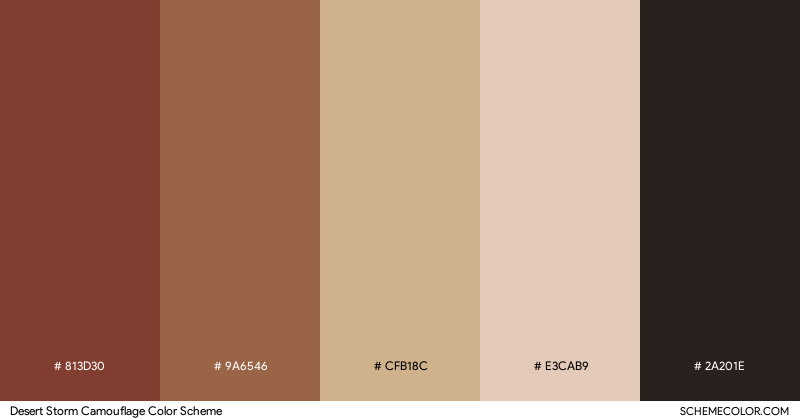
Desert Storm Camouflage color scheme is a unique color scheme with five that are Bole (#813D30), Coconut (#9A6546), Tan (#CFB18C), Desert Sand (#E3CAB9) and Raisin Black (#2A201E).
Beige Camouflage
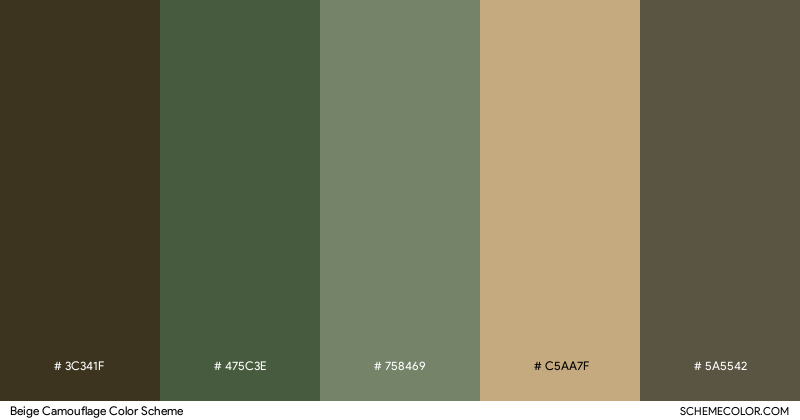
Beige Camouflage color palette consists of five colors which are Olive Drab #7 (#3C341F), Gray-Asparagus (#475C3E), Camouflage Green (#758469), Light French Beige (#C5AA7F) and Olive Drab Camouflage (#5A5542).
A Different Camouflage
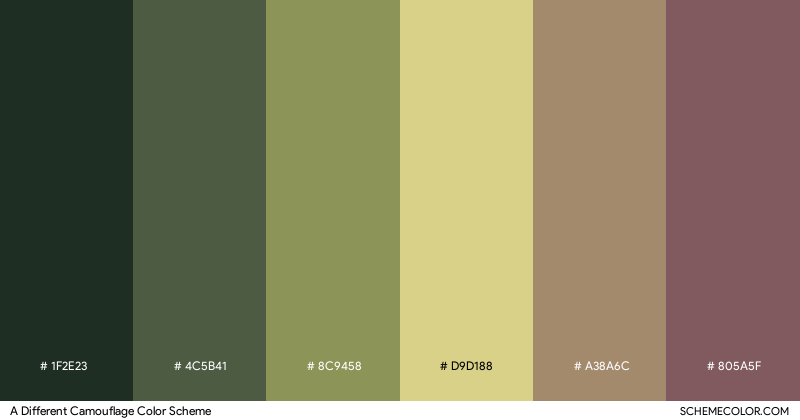
Made up of six colors, the A Different Camouflage color palette is a uniquely attractive scheme. The closest names and the exact hex codes of the colors are Charleston Green (#1F2E23), Gray-Asparagus (#4C5B41), Moss Green (#8C9458), Medium Spring Bud (#D9D188), Beaver (#A38A6C) and Deep Taupe (#805A5F).
Mud Camouflage
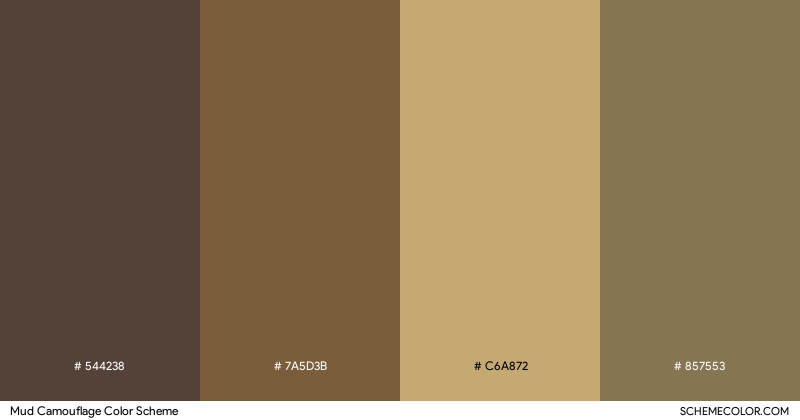
Mud Camouflage color scheme has four colors which are Royal Brown (#544238), Coyote Brown (#7A5D3B), Light French Beige (#C6A872) and Gold Fusion (#857553).
Camouflage Forest
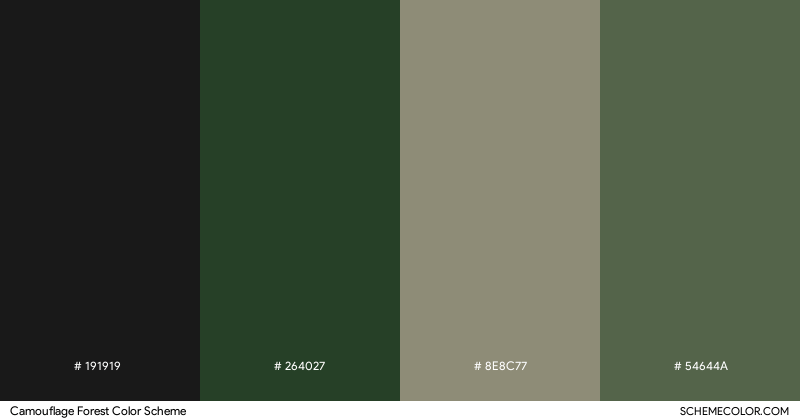
Camouflage Forest color palette has four colors which are Eerie Black (#191919), Black Leather Jacket (#264027), Artichoke (#8E8C77) and Ebony (#54644A).
Arid Land Camouflage
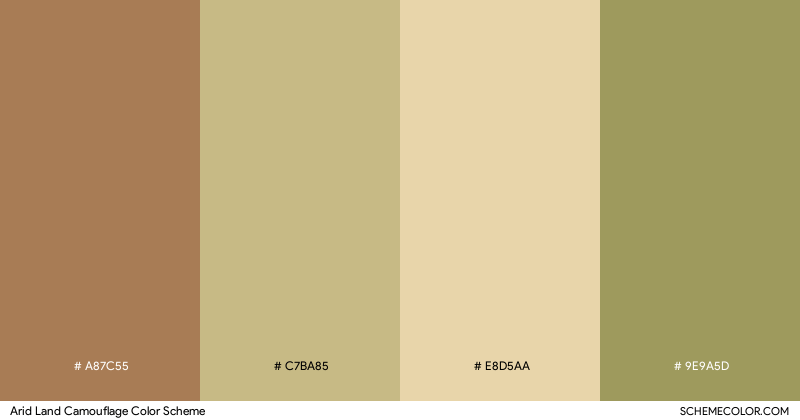
Arid Land Camouflage color palette consists of four colors which are Café Au Lait (#A87C55), Ecru (#C7BA85), Desert Sand (#E8D5AA) and Moss Green (#9E9A5D).
Green Camouflage
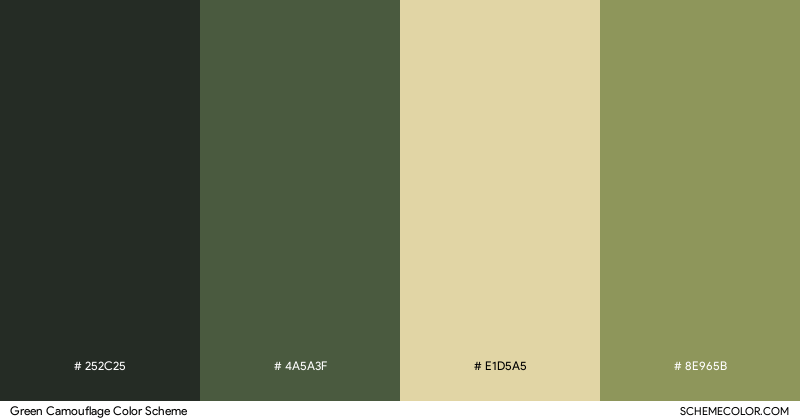
There are four colors in Green Camouflage color scheme. The hex codes and the corresponding closest english names of these colors are Pine Tree (#252C25), Gray-Asparagus (#4A5A3F), Desert Sand (#E1D5A5) and Moss Green (#8E965B).
Desert Camouflage Uniform (DCU)
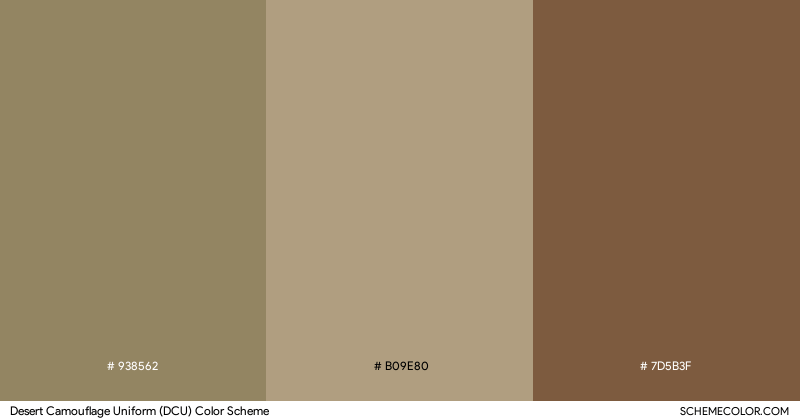
The lovely Desert Camouflage Uniform (DCU) color palette is made of three colors – Shadow (#938562), Grullo (#B09E80) and Coyote Brown (#7D5B3F).
Universal Camouflage Pattern (UCP)
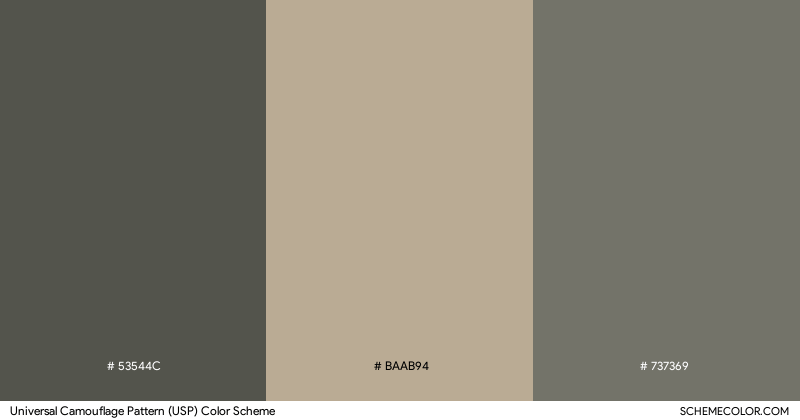
Made up of three colors, the Universal Camouflage Pattern (USP) color scheme is a uniquely attractive scheme. The closest names and the exact hex codes of the colors are Davy’s Grey (#53544C), Sage (#BAAB94) and Dark Silver (#737369).
Military Camouflage

Military Camouflage is an awesome scheme with a set of six colors. The hex codes and the equivalent names of these colors are Jacko Bean (#3F3B2E), Café Au Lait (#A4895C), Olive Drab Camouflage (#5B533F), Boy Red (#736246), Pale Brown (#96794E) and Pine Tree (#252B1F).
Orange Camouflage

There are six colors in Orange Camouflage color palette. The hex codes and the corresponding closest english names of these colors are Bistre (#34251A), Light Taupe (#BA9069), Dirty Brown (#A46324), Pineapple (#5E330B), Meat Brown (#F1AB32) and Deep Carrot Orange (#EA6729).
German Arid Camouflage

German Arid Camouflage uniquely beautiful scheme has three colors – Dark Brown (#68391E), Silver Pink (#BAAF9D) and Deep Moss Green (#405A35).
US Marine Camouflage Pattern (MARPAT)

US Marine Camouflage Pattern (MARPAT) color palette has four colors which are Dark Charcoal (#2E2C35), Shadow (#896E60), Cinereous (#95837A) and Feldgrau (#4E5B51).
Universal Camouflage Pattern (UCP)

The lovely Universal Camouflage Pattern (UCP) color palette is made of three colors – Davy’s Grey (#53544C), Dark Silver (#737369) and Sage (#BAAB93).
US Army Camouflage Pattern (OCP)
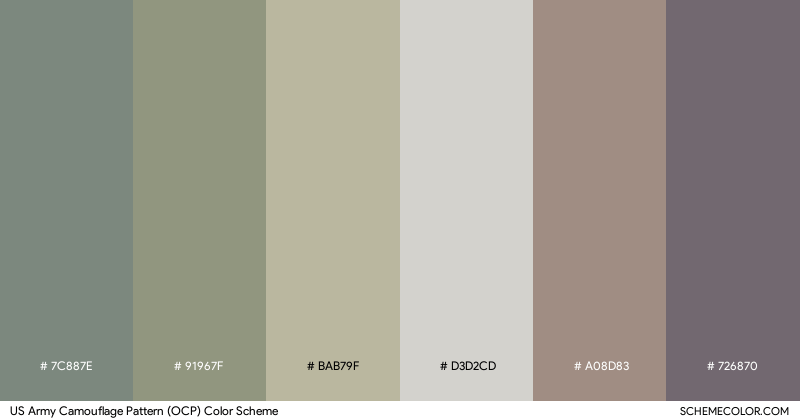
With six colors, US Army Camouflage Pattern (OCP) is a lovely color scheme with Gray (#7C887E), Artichoke (#91967F), Laurel Green (#BAB79F), American Silver (#D3D2CD), Grullo (#A08D83) and Dark Silver (#726870).
Battle Dress Uniform (BDU)
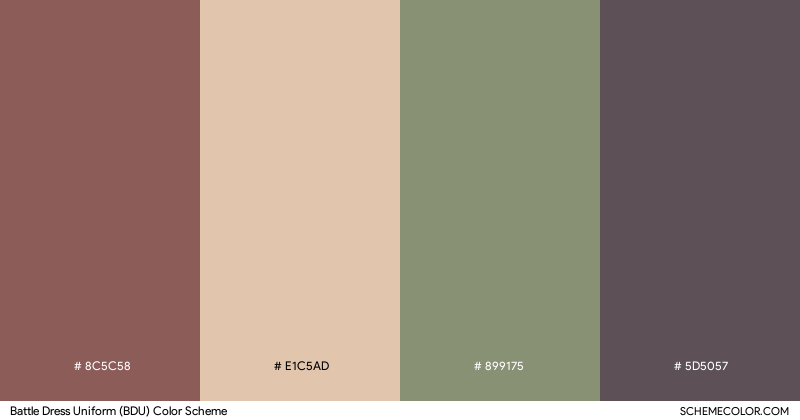
Consisting of four colors, the beautiful Battle Dress Uniform (BDU) color palette is made up of Rose Taupe (#8C5C58), Desert Sand (#E1C5AD), Artichoke (#899175) and Wenge (#5D5057).
Desert Battle Dress Uniform (DBDU)
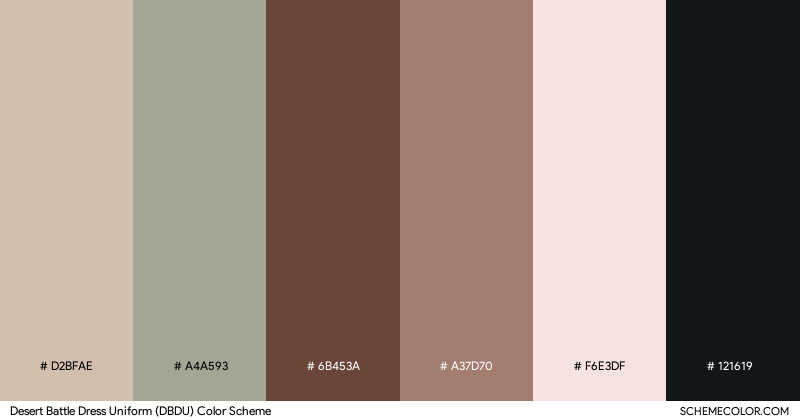
Desert Battle Dress Uniform (DBDU) color scheme has six colors which are Dark Vanilla (#D2BFAE), Grullo (#A4A593), Deep Coffee (#6B453A), Burnished Brown (#A37D70), Misty Rose (#F6E3DF) and Chinese Black (#121619).
Arid Camo (MARPAT)
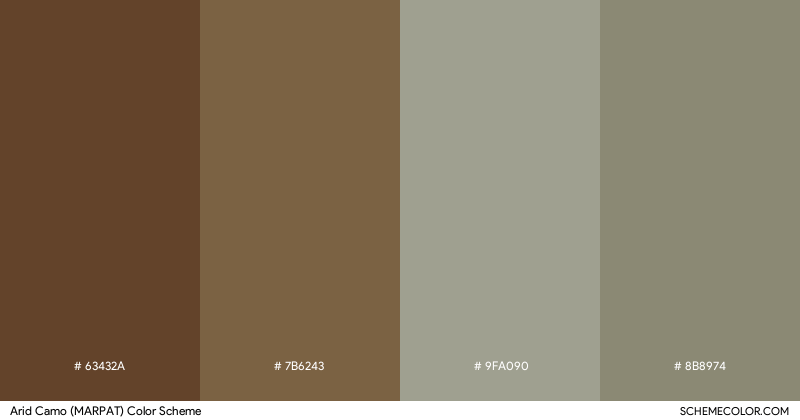
With four colors, Arid Camo (MARPAT) is a lovely color scheme with Cologne Earth Brown (#63432A), Raw Umber (#7B6243), Spanish Gray (#9FA090) and Middle Grey (#8B8974).
CADPAT – Temperate Woodland
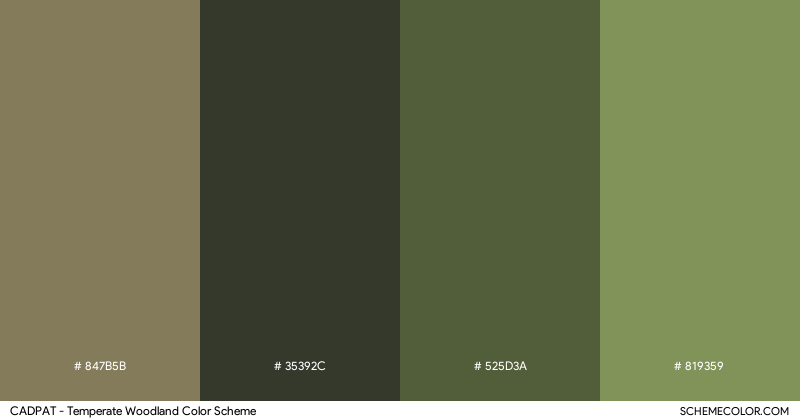
Made up of four colors, the CADPAT – Temperate Woodland color palette is a uniquely attractive scheme. The closest names and the exact hex codes of the colors are Shadow (#847B5B), Dark Charcoal (#35392C), Olive Drab Camouflage (#525D3A) and Moss Green (#819359).
Closing Words
Camouflage patterns definitely give an impression of ruggedness! And it’s this sturdiness and masculinity that draws us common folks (civilians) towards them. I can confidently say that every man who lives in the “urban jungle”, far removed from any battle zone, has, at one point in his life, owned at least something that had camouflage colors and patterns.
But why? Well, that could be because of a primitive calling of presenting a rough-n-tough look or simply a fascination for the armed forces.
One typically associates camouflage color schemes with drab, olive, brown or other earthy colors. These may be ideal for a jungle/forest environments but would fail miserably in desert or alpine territories.
For this reason, it is imperative to select both the pattern and the colors for an effective camouflage. Please also understand that no single camouflage pattern or a set of colors (palette or scheme) works in all the varied environments known to man.















































